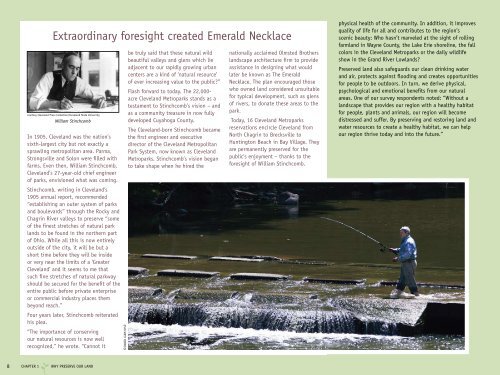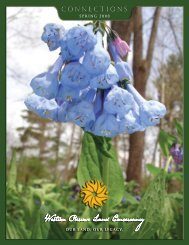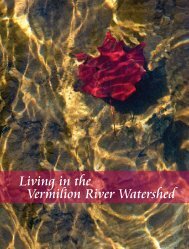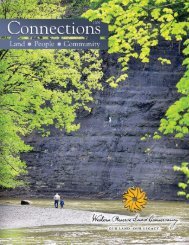Common Ground - Western Reserve Land Conservancy
Common Ground - Western Reserve Land Conservancy
Common Ground - Western Reserve Land Conservancy
Create successful ePaper yourself
Turn your PDF publications into a flip-book with our unique Google optimized e-Paper software.
In 1905, Cleveland was the nation’s<br />
sixth-largest city but not exactly a<br />
sprawling metropolitan area. Parma,<br />
Strongsville and Solon were filled with<br />
farms. Even then, William Stinchcomb,<br />
Cleveland’s 27-year-old chief engineer<br />
of parks, envisioned what was coming.<br />
Stinchcomb, writing in Cleveland’s<br />
1905 annual report, recommended<br />
“establishing an outer system of parks<br />
and boulevards” through the Rocky and<br />
Chagrin River valleys to preserve “some<br />
of the finest stretches of natural park<br />
lands to be found in the northern part<br />
of Ohio. While all this is now entirely<br />
outside of the city, it will be but a<br />
short time before they will be inside<br />
or very near the limits of a ‘Greater<br />
Cleveland’ and it seems to me that<br />
such fine stretches of natural parkway<br />
should be secured for the benefit of the<br />
entire public before private enterprise<br />
or commercial industry places them<br />
beyond reach.”<br />
Four years later, Stinchcomb reiterated<br />
his plea.<br />
“The importance of conserving<br />
our natural resources is now well<br />
recognized,” he wrote. “Cannot it<br />
8 CHAPTER 1 WHY PRESERVE OUR LAND<br />
Extraordinary foresight created Emerald Necklace<br />
courtesy Cleveland Press Collection/Cleveland State University<br />
© DAVID LIAM KYLE<br />
be truly said that these natural wild<br />
beautiful valleys and glens which lie<br />
adjacent to our rapidly growing urban<br />
centers are a kind of ‘natural resource’<br />
of ever increasing value to the public?”<br />
Flash forward to today. The 22,000acre<br />
Cleveland Metroparks stands as a<br />
testament to Stinchcomb’s vision – and<br />
as a community treasure in now fully<br />
developed Cuyahoga County.<br />
The Cleveland-born Stinchcomb became<br />
the first engineer and executive<br />
director of the Cleveland Metropolitan<br />
Park System, now known as Cleveland<br />
Metroparks. Stinchcomb’s vision began<br />
to take shape when he hired the<br />
nationally acclaimed Olmsted Brothers<br />
landscape architecture firm to provide<br />
assistance in designing what would<br />
later be known as The Emerald<br />
Necklace. The plan encouraged those<br />
who owned land considered unsuitable<br />
for typical development, such as glens<br />
of rivers, to donate these areas to the<br />
park.<br />
Today, 16 Cleveland Metroparks<br />
reservations encircle Cleveland from<br />
North Chagrin to Brecksville to<br />
Huntington Beach in Bay Village. They<br />
are permanently preserved for the<br />
public’s enjoyment – thanks to the<br />
foresight of William Stinchcomb.<br />
physical health of the community. In addition, it improves<br />
quality of life for all and contributes to the region’s<br />
scenic beauty: Who hasn’t marveled at the sight of rolling<br />
farmland in Wayne County, the Lake Erie shoreline, the fall<br />
colors in the Cleveland Metroparks or the daily wildlife<br />
show in the Grand River Lowlands?<br />
Preserved land also safeguards our clean drinking water<br />
and air, protects against flooding and creates opportunities<br />
for people to be outdoors. In turn, we derive physical,<br />
psychological and emotional benefits from our natural<br />
areas. One of our survey respondents noted: “Without a<br />
landscape that provides our region with a healthy habitat<br />
for people, plants and animals, our region will become<br />
distressed and suffer. By preserving and restoring land and<br />
water resources to create a healthy habitat, we can help<br />
our region thrive today and into the future.”









